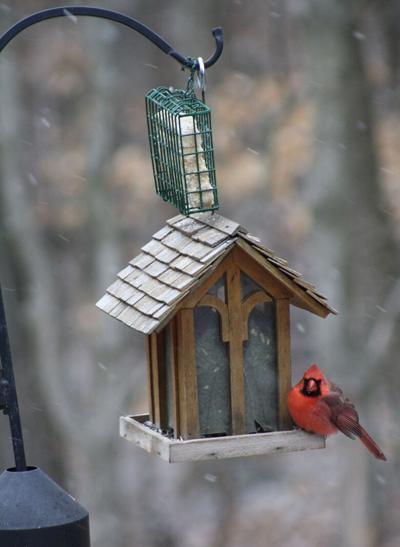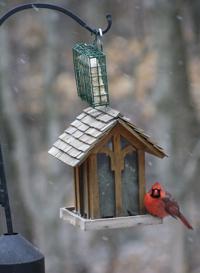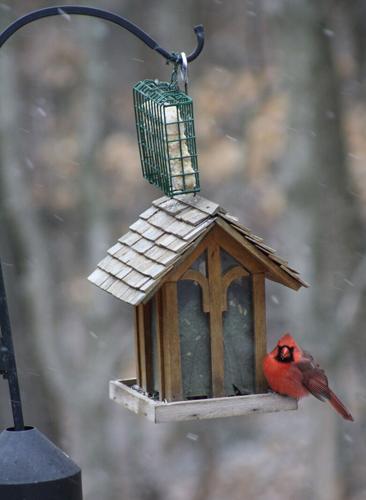While there certainly is no such thing as the perfect Christmas gift for everyone, I believe that wild bird feeders might be close. From little children to home-bound seniors, the color and clamor that can surround a feeder is a treat for the eyes and soul all year long.
Obviously they come with the baggage of having to keep them filled and the demolition that can happen to the ground beneath them, but bird feeders can be inexpensive or ridiculously ornate, technological and pricey gifts. A hand-made one, painted by a grandchild, would be a joyful reminder of two-way love.
The Cornell Lab of Ornithology's allaboutbirds.org website has an excellent analysis of the most common types of bird feeders along with just about everything you could want to know about the flying and flitting feathered friends we can invite to dinner in our backyards.
The best bird feeders keep the food dry, the squirrels out and are easy to fill and keep clean.
Spreading or spilling a bit on the ground beneath your feeder is a payoff for the ground feeders like juncos and mourning doves that prefer to pick their meals off the earth rather than land on the perches. The birds that do visit the feeder will also drop plenty on the ground for those willing to enjoy scraps from the table.
Hopper or house-type feeders protect the seeds fairly well. Depending on the size of the barn or bin, they can hold enough seeds so they do not need to be filled for days. While the roof generally keeps the seeds dry, if they do get wet, bacteria or fungus can build up in the feeder and be detrimental to the birds.
Tube feeders keep the seeds dry, and if they have metal ports for the birds to collect the seeds, they are relatively squirrel proof. Unfortunately the tree rats can be relentless and chew through any plastic parts, so a squirrel baffle is recommended for all feeder types.
A design flaw for the tube feeder is that the openings don't always go all the way to the bottom of the cylinder, so there is food that can't be accessible. When refilling a tube feeder you should dump out the uneaten seeds before adding new.
The most common nyjer (thistle) seed feeders are tube types with tiny slits for ports. These specialized feeders attract a variety of finches, including the male goldfinch who looks brown this time of year, but will be glorious yellow when spring returns. The little black litter that falls to the ground is not spilled seed, but actually the shell of the thistle seed. The finches eat just the tiny morsel from inside of each shell.
Suet feeders can be as simple as the old mesh sack from a bag of onions or oranges, filled with beef fat trimmings, but modern convenience has created the suet cake to fit in wire mesh cages with a variety of sizes and designs.
Suet feeders attract woodpeckers and like the pretty little song birds you can see at the other types of feeders, woodpeckers range in size from wren-like peepers to squawking giants. Technically nuthatches are not woodpeckers but their appearance, activity and fondness for suet makes them seem so.
Most woodpeckers we see in Missouri are black and white with hints of bright red. The most common are the downy and hairy woodpeckers, which are almost identical except for size and beak shape. Hairy has a pointier proboscis and is just a little larger than downy.
The red-bellied woodpecker has a shade of red on his crown, and a more pastel appearance overall. A red-headed woodpecker is solid crimson for his full face, neck and head while his body is more distinctly black and white, in the fashion of the 1980s plain-label food packaging.
The pileated woodpecker is the one most like the cartoon creation Woody, but black and white instead of blue. In addition to the biggest of these birds, he can be almost as loud and grating when he opens his mouth as the caricature.
My favorite is the northern flicker. His mostly brown body breaks the stereotype by not being mostly black and white, and when he flies away, his tell-tale bright rump spot is so unique.
The variety of birds you get to see are based on the types of food you provide. Black oil sunflowers are favorites of cardinals, finches, titmice, chickadees, and other song birds. Whole grains like millet, milo and cracked corn are less expensive and attract additional species like sparrows, jays and the ground feeders that enjoy the overflows of those small seeds.
Regardless of your choice of food or feeder, attracting birds to watch is a gift for you and them, all year long.
John Winkelman is Marketing Manager for Liguori Publications near Barnhart, Mo., and the Associate Editor for Outdoor Guide Magazine. If you have story ideas to share for the Leader outdoor news page, e-mail ogmjohnw@aol.com, and you can follow John on Twitter at @johnjwink99.





